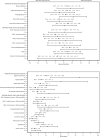Nurse home visiting to improve child and maternal outcomes: 5-year follow-up of an Australian randomised controlled trial
- PMID: 36441705
- PMCID: PMC9704648
- DOI: 10.1371/journal.pone.0277773
Nurse home visiting to improve child and maternal outcomes: 5-year follow-up of an Australian randomised controlled trial
Abstract
Objectives: Nurse home visiting (NHV) is widely implemented to address inequities in child and maternal health. However, few studies have examined longer-term effectiveness or delivery within universal healthcare systems. We evaluated the benefits of an Australian NHV program ("right@home") in promoting children's language and learning, general and mental health, maternal mental health and wellbeing, parenting and family relationships, at child ages 4 and 5 years.
Setting and participants: Randomised controlled trial of NHV delivered via universal, child and family health services (the comparator). Pregnant women experiencing adversity (≥2 of 10 risk factors) were recruited from 10 antenatal clinics across 2 states (Victoria, Tasmania) in Australia.
Intervention: Mothers in the intervention arm were offered 25 nurse home visits (mean 23·2 home visits [SD 7·4, range 1-43] received) of 60-90 minutes, commencing antenatally and continuing until children's second birthdays.
Primary and secondary outcomes measured: At 4 and 5 years, outcomes were assessed via parent interview and direct assessment of children's language and learning (receptive and expressive language, phonological awareness, attention, and executive function). Outcomes were compared between intervention and usual care arms (intention to treat) using adjusted regression with robust estimation to account for nurse/site. Missing data were addressed using multiple imputation and inverse probability weighting.
Results: Of 722 women enrolled in the trial, 225 of 363 (62%) intervention and 201 of 359 (56%) usual care women provided data at 5 years. Estimated group differences showed an overall pattern favouring the intervention. Statistical evidence of benefits was found across child and maternal mental health and wellbeing, parenting and family relationships with effect sizes ranging 0·01-0·27.
Conclusion: An Australian NHV program promoted longer-term family functioning and wellbeing for women experiencing adversity. NHV can offer an important component of a proportionate universal system that delivers support and intervention relative to need.
Trial registration: 2013-2016, registration ISRCTN89962120.
Copyright: © 2022 Goldfeld et al. This is an open access article distributed under the terms of the Creative Commons Attribution License, which permits unrestricted use, distribution, and reproduction in any medium, provided the original author and source are credited.
Conflict of interest statement
The “right@home” sustained nurse home visiting trial is a research collaboration between the Australian Research Alliance for Children and Youth (ARACY); the Translational Research and Social Innovation (TReSI) Group at Western Sydney University; and the Centre for Community Child Health (CCCH), which is a department of The Royal Children’s Hospital and a research group of Murdoch Children’s Research Institute. Ownership of the right@home implementation and support licence, which is purchased by Australian state governments for roll out, is shared between institutes.
Figures



References
-
- World Health Organization. Closing the gap in a generation: Health equity through action on the social determinants of health. World Health Organization, Commission on Social Determinants of Health; 2008. Report No.: 924068333X.
-
- Shonkoff JP, Phillips DA. From Neurons to Neighborhoods: The Science of Early Childhood Development. Washington, DC: The National Academy Press; 2000. - PubMed
-
- Starfield B. Primary care and equity in health: The importance to effectiveness and equity of responsiveness to peoples’ needs. Humanity & Society. 2009;33(1–2):56–73.
Publication types
MeSH terms
LinkOut - more resources
Full Text Sources

